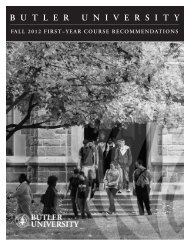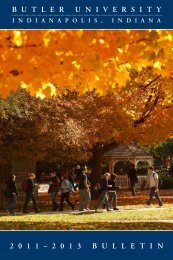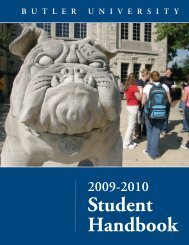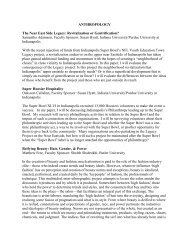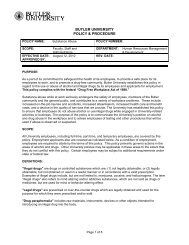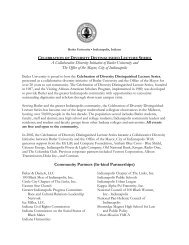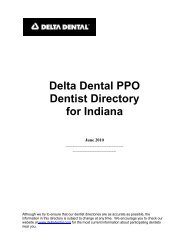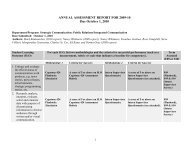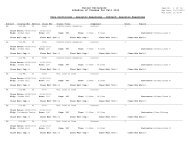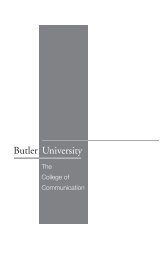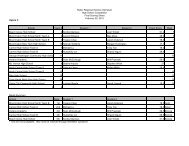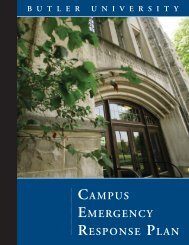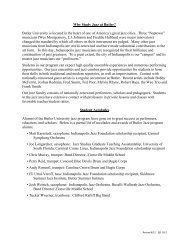ROWing Through Fall Creek - Butler University
ROWing Through Fall Creek - Butler University
ROWing Through Fall Creek - Butler University
Create successful ePaper yourself
Turn your PDF publications into a flip-book with our unique Google optimized e-Paper software.
<strong>ROWing</strong> through <strong>Fall</strong> <strong>Creek</strong><br />
This metric found two stoplights, five crosswalks and two parking lots within the area of study. These<br />
numbers reflect a lack of connectivity between the community and waterways of Indianapolis. <strong>Fall</strong> <strong>Creek</strong><br />
Parkway is not pedestrian friendly, making stoplights and crosswalks more important for the safety of the<br />
MFCN residents.<br />
A third metric the class will use for connectivity is the community’s general awareness of and relationship<br />
with the river. Aspects of this metric will analyze and asses the community’s awareness of their physical<br />
proximity to the waterway, the awareness of their impact on water conditions, and their awareness of what<br />
role the river plays in their daily lives.<br />
To measure the community’s connectivity to their waterway, surveys that address these conditions will be<br />
conducted. Having an understanding the current conditions will create a baseline from which ROW can<br />
improve upon.<br />
The data from the behavioral and attitudes survey shows several over-arching trends that could be useful to<br />
ROW. The results, within the sample population, suggest that very few people know the current status of<br />
water quality in <strong>Fall</strong> <strong>Creek</strong>. The results also suggest that the sample population does not know where the<br />
water they use and drink on a daily basis comes from.<br />
ECOLOGY:<br />
Ecology is a broad element that relates to species, water quality and general habitat. R.O.W. will improve the<br />
physical, chemical and biological measures of water quality.<br />
The class will perform a stream assessment along <strong>Fall</strong> <strong>Creek</strong>. The assessment data sheet includes various<br />
questions related to the overall composition and condition of the stream. The Reach Level Assessment is<br />
composed of rating conditions such as water clarity, shading and wildlife. The final reach accessibility consists<br />
of a rating of 1-5 as well as determining if the stream environment is good, fair or difficult.<br />
The class will look at three different stretches of <strong>Fall</strong> <strong>Creek</strong> and perform a Unified Stream Assessment for<br />
each section. During the assessment, different attributes of the river will be analyzed, including habitat,<br />
vegetation, banks, erosion, and floodplain, as seen in Figures 3 - 6. This shows the results from each of the<br />
<strong>Fall</strong> <strong>Creek</strong> sections.<br />
Overall, the conditions of the sections sampled are suboptimal; two of the sections have this rating, while<br />
the third has a rating of marginal. The 38th Street bridge to the Monon has an overall score of 87, the area<br />
from the Monon to the 30th Street bridge has a score of 94, and the 30th Street bridge to Central Avenue<br />
area has a score of 74, all out of a possible 160 points.<br />
As the <strong>Fall</strong> <strong>Creek</strong> waterway flows closer to downtown Indianapolis, the condition of the river decreases.<br />
This could be due to many factors. The most probable factor, and also the most detrimental, is the result<br />
from human activities. As the river flows and the neighborhood becomes more encroached with residents<br />
and urban settings, the implications and effects on the river also increases. The increase in human activities<br />
and settlements has led to an increase in erosion on the river banks and also to a less spacious buffer area<br />
between the river and residential areas. With the more populous areas surrounding the river, it greatly affects<br />
the health of the river and the quality of its water.<br />
The class will develop a metric to measure the amount of honeysuckle cover there is in the <strong>Fall</strong> <strong>Creek</strong> cor-<br />
8



